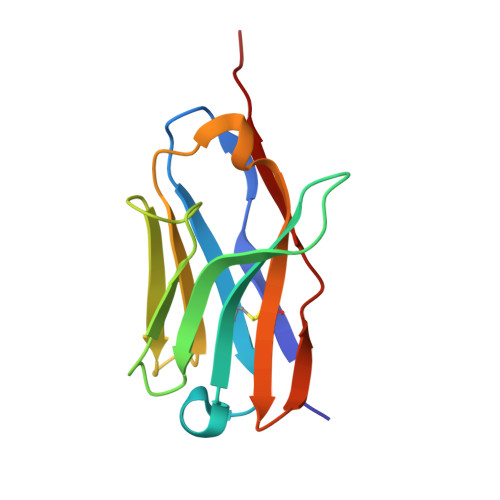Structure defining of ultrapotent neutralizing nanobodies against MERS-CoV with novel epitopes on receptor binding domain.
Ma, S., Zhang, D., Wang, Q., Zhu, L., Wu, X., Ye, S., Wang, Y.(2024) PLoS Pathog 20: e1012438-e1012438
- PubMed: 39141662
- DOI: https://doi.org/10.1371/journal.ppat.1012438
- Primary Citation of Related Structures:
8YSF, 8YSH - PubMed Abstract:
The Middle East Respiratory Syndrome Coronavirus (MERS-CoV) causes severe and fatal acute respiratory disease in humans. High fatality rates and continued infectiousness remain a pressing concern for global health preparedness. Antibodies targeted at the receptor-binding domain (RBD) are major countermeasures against human viral infection. Here, we report four potent nanobodies against MERS-CoV, which are isolated from alpaca, and especially the potency of Nb14 is highest in the pseudotyped virus assay. Structural studies show that Nb14 framework regions (FRs) are mainly involved in interactions targeting a novel epitope, which is entirely distinct from all previously reported antibodies, and disrupt the protein-carbohydrate interaction between residue W535 of RBD and hDPP4 N229-linked carbohydrate moiety (hDPP4-N229-glycan). Different from Nb14, Nb9 targets the cryptic face of RBD, which is distinctive from the hDPP4 binding site and the Nb14 epitope, and it induces the β5-β6 loop to inflect towards a shallow groove of the RBD and dampens the accommodation of a short helix of hDPP4. The particularly striking epitopes endow the two Nbs administrate synergistically in the pseudotyped MERS-CoV assays. These results not only character unprecedented epitopes for antibody recognition but also provide promising agents for prophylaxis and therapy of MERS-CoV infection.
Organizational Affiliation:
Frontiers Science Center for Synthetic Biology (Ministry of Education), Tianjin Key Laboratory of Function and Application of Biological Macromolecular Structures, School of Life Sciences, Tianjin University, Tianjin, P.R. China.















